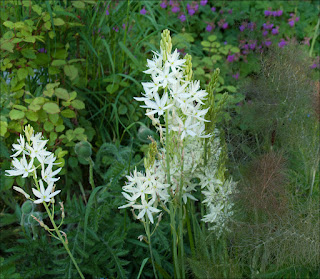The Evolution of a small garden, lots of mistakes, lots of hard work, for those who love gardening.
Saturday, 26 June 2021
GOINGS AND COMINGS
Sunday, 20 June 2021
THE SHRUB MONTH?

 The garden is very dry and bare cracked patches have appeared in the grass. I have watered but not excessively for that has been some dew in the morning. One exception is the sweet peas and they are still alive! This is most unusual for me, normally they are dead and eaten by now. The chives that line the path in the veg garden are, however, flowering profusely. Not what we really want as the flowering stems are stiff and hard, not pleasant to eat. (You can eat the flowers though.)
The garden is very dry and bare cracked patches have appeared in the grass. I have watered but not excessively for that has been some dew in the morning. One exception is the sweet peas and they are still alive! This is most unusual for me, normally they are dead and eaten by now. The chives that line the path in the veg garden are, however, flowering profusely. Not what we really want as the flowering stems are stiff and hard, not pleasant to eat. (You can eat the flowers though.)
There are also successful partnerships - catmint and the cultivated alchemilla. The colours enhance one another.
Elsewhere the woodland still is full of red campion and the rather unsuccessful wild flower meadow has, at least, some yellow rattle. It will take a few years I think. I could have used weed killer to get rid of all the grass but having seen that done by local farmers to create a monoculture of silage grass (and the disappearance of the curlews) I will not.
Saturday, 12 June 2021
MAY IN JUNE?
White is still important in the garden - the Sweet Cicely (beware of its ability as a wild flower to invade and spread), camassias and hesperis.


R has removed most of the over forget-me-nots and put them up in the wood where they will self sow a bit. This leaves spaces to fill. I must think about that.
Up in the wood, when the sun shines on the campion and pignut it is a delight.

And then there is wild life in the garden - newts, frogs and toads with the water boatmen, damselflies and whirligigs in the pond, rabbits, grey squirrels, woodlice, bank voles and pheasants in the wood, and then visitors - badgers, foxes and -
Saturday, 5 June 2021
SUMMER AT LAST
We went to Muncaster and missed the bluebells as they were over but the rhododendrons and shrubs were good.

After all the moaning about the cold weather it is Wednesday and 26C. We have been given some canna lilies and now I have to decide where to put them!
I have sown parsley and courgettes, some carrots and tied up the remaining straggly sweet peas - not given up quite yet.
Lawns mown and every time I walk about I pull up broad-leaved willowherb and goosegrass (cleavers).
The banking grass is growing apace and the farmers here are silaging hard.
The woodland floor is mostly red campion but where we have scattered forget-me-nots they mix with there wild pignut to give a different carpet.

 The wild flower meadow area does have a few yellow rattle but so far little else - lot of work, not much return, keep hoping. The sorrel is flowering but that was there anyway. One plant that is looking good is the white camassia and I have several more in bud but I have forgotten what colour they are so will it be a surprise? Actually unlikely.
The wild flower meadow area does have a few yellow rattle but so far little else - lot of work, not much return, keep hoping. The sorrel is flowering but that was there anyway. One plant that is looking good is the white camassia and I have several more in bud but I have forgotten what colour they are so will it be a surprise? Actually unlikely. And it is not only flowers that give colour - many new leaves have their own attractiveness whether the choisya or the rhododendrons.
And it is not only flowers that give colour - many new leaves have their own attractiveness whether the choisya or the rhododendrons.
















































